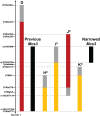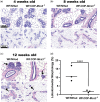Rat Mammary carcinoma susceptibility 3 (Mcs3) pleiotropy, socioenvironmental interaction, and comparative genomics with orthologous human 15q25.1-25.2
- PMID: 36315068
- PMCID: PMC9836357
- DOI: 10.1093/g3journal/jkac288
Rat Mammary carcinoma susceptibility 3 (Mcs3) pleiotropy, socioenvironmental interaction, and comparative genomics with orthologous human 15q25.1-25.2
Abstract
Genome-wide association studies of breast cancer susceptibility have revealed risk-associated genetic variants and nominated candidate genes; however, the identification of causal variants and genes is often undetermined by genome-wide association studies. Comparative genomics, utilizing Rattus norvegicus strains differing in susceptibility to mammary tumor development, is a complimentary approach to identify breast cancer susceptibility genes. Mammary carcinoma susceptibility 3 (Mcs3) is a Copenhagen (COP/NHsd) allele that confers resistance to mammary carcinomas when introgressed into a mammary carcinoma susceptible Wistar Furth (WF/NHsd) genome. Here, Mcs3 was positionally mapped to a 7.2-Mb region of RNO1 spanning rs8149408 to rs107402736 (chr1:143700228-150929594, build 6.0/rn6) using WF.COP congenic strains and 7,12-dimethylbenz(a)anthracene-induced mammary carcinogenesis. Male and female WF.COP-Mcs3 rats had significantly lower body mass compared to the Wistar Furth strain. The effect on female body mass was observed only when females were raised in the absence of males indicating a socioenvironmental interaction. Furthermore, female WF.COP-Mcs3 rats, raised in the absence of males, did not develop enhanced lobuloalveolar morphologies compared to those observed in the Wistar Furth strain. Human 15q25.1-25.2 was determined to be orthologous to rat Mcs3 (chr15:80005820-82285404 and chr15:83134545-84130720, build GRCh38/hg38). A public database search of 15q25.1-25.2 revealed genome-wide significant and nominally significant associations for body mass traits and breast cancer risk. These results support the existence of a breast cancer risk-associated allele at human 15q25.1-25.2 and warrant ultrafine mapping of rat Mcs3 and human 15q25.1-25.2 to discover novel causal genes and variants.
Keywords: body mass; breast cancer susceptibility; genotype by environment interaction; human 15q25.1-25.2; mammary gland development; rat Mcs3.
© The Author(s) 2022. Published by Oxford University Press on behalf of Genetics Society of America.
Conflict of interest statement
The authors have no conflicts of interest to declare.
Figures








Similar articles
-
Physical Confirmation and Comparative Genomics of the Rat Mammary carcinoma susceptibility 3 Quantitative Trait Locus.G3 (Bethesda). 2017 Jun 7;7(6):1767-1773. doi: 10.1534/g3.117.039388. G3 (Bethesda). 2017. PMID: 28391240 Free PMC article.
-
Rat Mcs1b is concordant to the genome-wide association-identified breast cancer risk locus at human 5q11.2 and MIER3 is a candidate cancer susceptibility gene.Cancer Res. 2012 Nov 15;72(22):6002-12. doi: 10.1158/0008-5472.CAN-12-0748. Epub 2012 Sep 19. Cancer Res. 2012. PMID: 22993404 Free PMC article.
-
Significant overlap between human genome-wide association-study nominated breast cancer risk alleles and rat mammary cancer susceptibility loci.Breast Cancer Res. 2014 Jan 27;16(1):R14. doi: 10.1186/bcr3607. Breast Cancer Res. 2014. PMID: 24467842 Free PMC article.
-
The genetic components of susceptibility to breast cancer in the rat.Prog Exp Tumor Res. 1999;35:158-69. doi: 10.1159/000062012. Prog Exp Tumor Res. 1999. PMID: 10377759 Review.
-
Genetic regulation of mammary carcinogenesis in the rat by susceptibility and suppressor genes.Environ Health Perspect. 1991 Jun;93:161-7. doi: 10.1289/ehp.9193161. Environ Health Perspect. 1991. PMID: 1773787 Free PMC article. Review.
References
-
- Adler NT, Resko JA, Goy RW.. The effect of copulatory behavior on hormonal change in the female rat prior to implantation. Physiol Behav. 1970;5(9):1003–1007. - PubMed
-
- Ahn J, Schatzkin A, Lacey JV, Albanes D, Ballard-Barbash R, Adams KF, Kipnis V, Mouw T, Hollenbeck AR, Leitzmann MF, et al. . Adiposity, adult weight change, and postmenopausal breast cancer risk. Arch Intern Med. 2007;167(19):2091–2102. - PubMed
-
- Ainslie DA, Morris MJ, Wittert G, Turnbull H, Proietto J, Thorburn AW.. Estrogen deficiency causes central leptin insensitivity and increased hypothalamic neuropeptide Y. Int J Obes Relat Metab Disord. 2001;25(11):1680–1688. - PubMed
-
- Asarian L, Geary N.. Cyclic estradiol treatment normalizes body weight and restores physiological patterns of spontaneous feeding and sexual receptivity in ovariectomized rats. Horm Behav. 2002;42(4):461–471. - PubMed
Publication types
MeSH terms
LinkOut - more resources
Full Text Sources
Medical
Miscellaneous
